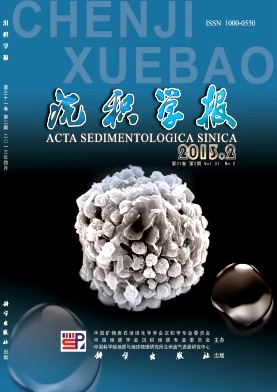Deposited Micro facies of Huangmaqing Formation in and Around Luzong Basin and Its Relationships with Rocks Series Containing Cu
- Publish Date: 2013-04-10
-
Key words:
- /
- Luzong basin /
- Huangmaqing Formatiom /
- copper rock /
- interdistributary bay /
- delta front subfacies
Abstract: Through geological profile and trunk route survey, the characteristics of sedimentary facies of Huangmaqing Formation in Luzong basin and its peripheral regions has been studied. Through testing of samples, the contents characteristics of Cu, Pb, Zn, Au, Ag and some other metal elements at the upper Huangmaqing Formation has been analysed. Further more, the accumulation beds of Cu and its mechanism of concentration has been tentatively discussed. Sedimentary sequence of Huangmaqing Formation in Luzong basin and its peripheral regions is typical river delta which includes front delta delta front subfacies. The Lower Huangmaqing Formation rich in marine fossil bivalve contains dark grey and purplish clay, silty clay, and a little micritic dolomite, calcareous clayey siltstone, whose sedimentary subfacies is front delta. The sedimentary subfacies of Upper Huangmaqing Formation containing mudstone and sandstone is delta front which developed mainly distal bar, rivermouth bar, interdistributary bay, distributary channel, natural levee microfacies. On the whole, it is coarseningupward sequence of regression deltaic. The background content of Cu calculated by 84 samples from Upper Huangmaqing Formation is 79.39×10 6. However, content of Cu of various rocks is obviously different, with that of silty mudstone 8 times significantly higher than sandstone. Further analysis manifests that the concentration of Cu in silty mudstone attributes to these grayish greendark gray silty mudstone and muddy siltstone deposited in reducing environments, thus its content of Cu is 10 times higher than the background values of Huangmaqing formation. Thus, Cu bearing stratiform of Huangmaqing Formation is silty mudstone and muddy siltstone covered with reduced colour of grayish greendark gray silty which deposited in interdistributary bay of delta front. The abundant organic matters and weak hydrodynamic forces of interdistributary bay is in favour of sedimentataion of organic matters carried by running water of distributary channel. The organic matters can obsorb Cu2+, Fe2+. At the same time, H2S generated by bacterial degradation of the organic matters to form the reductive environments where Cu2+, Fe2+contained in the fluid and gel deposited. Thus reducing materials such as chalcocite, bornite, chalcopyrite, pyrite have been generated and the Cu is concentrated. The mudstone and silty mudstone of Upper Huangmaqing Formation developed in interdistributary bay, thus mudstone content can reflect its development. The lithofacies paleogeography graph is plotted by ratio of rocks (contour map of mudstone/sandstone). By ratio of mudstone/sandstone of the section, the four areas of mudstone <10, 10~20, 20~30, >30 are determined through interpolation method which use contour value 10%, 20%, 30%. The four areas reflect the plane development of interdistributary bay microfacies and also the Cubearing stratiform. The lithofacies paleogeography graph manifests the Cubearing stratiform of Huangmaqing Formation is well developed to the east of YijinqiaoShiji in southcentral basin.
| Citation: | Deposited Micro facies of Huangmaqing Formation in and Around Luzong Basin and Its Relationships with Rocks Series Containing Cu[J]. Acta Sedimentologica Sinica, 2013, 31(2): 210-219. |






 DownLoad:
DownLoad: